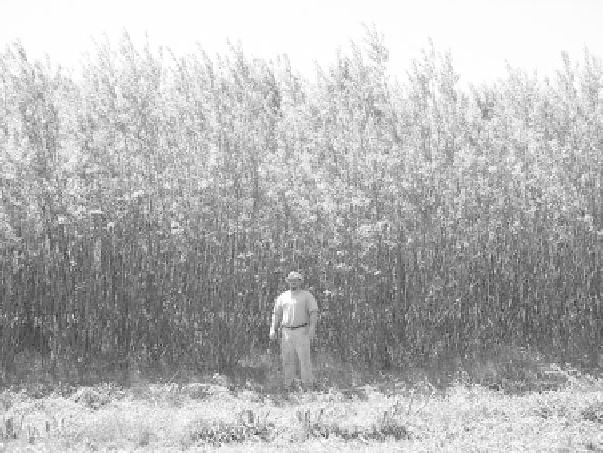Environmental Engineering Reference
In-Depth Information
FIGure 28.4
Example of a 4-year-old stand of shrub willow.
nutrients have fallen to the ground and will not be removed from the site; the plants have reallocated
energy and nutrients to below-ground storage tissues conserving energy to support spring regrowth;
the stem biomass holds less water during the winter months than during the growing season; and
when the ground is frozen, there is less chance for soil compaction and rutting of the field. However,
running harvesting operations during the winter becomes complicated by the presence of deep snow
and by the harsh working conditions of extremely cold temperatures. Harvesting can continue over
a 4- to 5-month period until just before bud break in the spring. After spring and early summer
harvesting, the plants will resprout and grow for the rest of the season, but the harvested biomass
will have a higher proportion of moisture and nitrogen.
Commercial harvesting is currently accomplished using either a self-propelled forage harvester
with a willow cutting head or using a sugarcane harvester. The willow cutting head on a self-
propelled forage harvester has two circular saw blades that cut the stems 6-8 cm above the ground,
pulling them into the chopper, which produces chips averaging 2-4 cm in size and blows them into
an adjacent forage box, dump wagon, or truck (Figure 28.5). This equipment has been designed
and sold commercially by Claas, New Holland, and Coppice Resources Ltd. with the intention that
the forage harvester can be used for multiple crops—hay, silage corn, and willow—by exchanging
the cutter head. Winter harvest of willow would be scheduled after the fall harvest of silage corn.
The sugarcane harvester saws the stems just above the ground and then chops them into 15- to
20-cm-long sections called “billets.” These larger pieces of stem are less likely to compost during
storage, but they will require further milling before they can be used to generate heat or power.
Prototype harvesters that saw, collect, and bundle the stems whole have also been designed, but they
are not widely used in commercial production systems.
The chips collected in a dump wagon or forage box are brought to the headlands of the field and
are loaded into either an open-top truck, when dump wagons are used, or are unloaded to a blower,
which blows the chips into a standard trailer. Because trucking costs are a significant component of
the harvesting expense, it is usually only economical to transport wet biomass no more than 75 km
(~50 mi) to market, and shorter distances are best (Keoleian and Volk 2005; Tharakan et al. 2005).
When used as fuel for a power plant, the harvested willow chips are unloaded from the truck—
either using a live bottom truck, dump truck, or by tipping an enclosed trailer on a whole-truck
dumper. The chips are usually conveyed to the top of a chip pile, where they are stored—either

